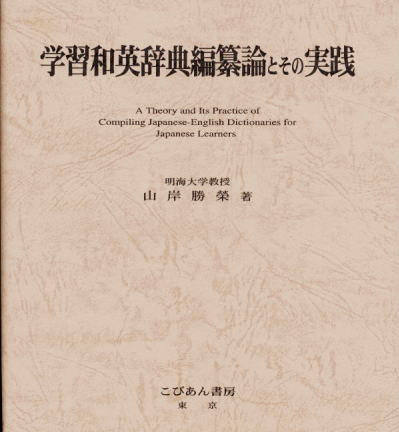
| 学位(応用言語学博士)取得論文 論文博士(応用言語学)の軌跡 |
本書書評に関してはここ(書評1、 書評2、書評3)をご覧下さい。また、こちらもご覧下さい。
山 岸 勝 榮 著
『学習和英辞典編纂論とその実践』
YAMAGISHI, Katsuei
A Theory and Its Practice of Compiling Japanese-English Dictionaries
for Japanese Learners
( 東京:こびあん書房刊、2001)
A5版 ・上製、 定価 4,000円、xiv+479 pp.
ISBN4-87558-063-0 C3082
■こびあん書房 ℡ 03 (3941) 4683

| 本書は、学習和英辞典の望ましい姿を追い求めて、たどり着いた私の1つの結論です。本書に登場する学習和英辞典の欠点・弱点を改良し、より望ましいものに仕上げて行くのが、それらを利用する人々への辞書関係者の社会的責任であり、先輩辞書関係者への礼儀であろうと思います。 |
|
In this book the author has analyzed, categorized, and discussed the problems that are included in EFL Japanese-English dictionaries and has presented specific alternative measures to help compile better dictionaries. The twenty-two chapters of the book and the main points of each chapter are as follows: Chap.1. A short history of Japanese-English dictionaries. This chapter sketches out a history of Japanese-English dictionaries from J. C. Hepburn’s Japanese-English Dictionary (1867), the first Japanese-English dictionary, to the latest Japanese-English dictionaries. Chap.2. Japanese-English dictionaries― their targets and purposes. The author gives a definition of a Japanese-English dictionary and points out the basic differences between a Japanese-English dictionary and an English-Japanese dictionary. Chap.3. Criteria of selecting entry words and their methods The author sets definite criteria and proposes methods for selecting entry words for a Japanese-English dictionary. Chap.4. Conditions of good EFL dictionaries. The author presents the conditions of good EFL dictionaries and maintains that they should deal with the“working vocabulary”carefully. Chap.5. What kinds of English should be included in a Japanese-English dictionary. British English or American English is recommended as the target variety of English for a Japanese-English dictionary. Chap.6. Problems related to English words for Japanese entry words. The author stresses the need of correct analysis of the meanings of Japanese entry words and giving appropriate English words or phrases to illustrate their use. Chap.7. Problems related to illustrative phrases and sentences. The author strongly feels a need to reexamine the illustrative phrases and sentences in EFL dictionaries published in Japan since they often include unnatural examples for Japanese learners. Chap.8. Personal names and their treatment in EFL Japanese-English dictionaries. The author shows examples of how an EFL Japanese-English dictionary should choose personal names for dictionary use. Chap.9. Gender in illustrative phrases and sentences. The author deals with the problems of bias-free English for dictionary use and suggests guidelines for bias-free and non-sexist usage. Chap.10. Problems related to English sentences. Quite a few illustrative sentences in Japanese-English dictionaries are unnatural and this unnaturalness has apparently been caused by inappropriate analysis of Japanese entry words. Chap.11. Problems related to register clash. Japanese learners often mix informal English words with formal English words (and vice versa), which results in writing / speaking unnatural English. In this chapter problems which are related to register clash and linguistic facts which are apt to escape the notice of Japanese EFL learners are considered. Chap.12. Problems related to speech levels. Japanese entry words and their equivalent words in translation often result in a clash of stylistic varieties. Informal words are often given as equivalent words to formal entry words (and vice versa). Here the author discusses how to avoid mixing formal and informal styles. Chap.13. Problems related to paraphrasing and indicating how to translate from Japanese to English. Here the author argues that incorrect paraphrasing of Japanese words or phrases leads to incorrect translation. Chap.14. EFL Japanese-English dictionaries and their problems related to English sounds. The author argues how much space a Japanese-English dictionary should take for dealing with English sounds or pronunciation. Chap.15. Problems related to the participation of native English speakers in editing an EFL Japanese-English dictionary. The author testifies with many examples that, in compiling a Japanese-English dictionary, full participation of native English speakers is indispensable. Chap.16. EFL Japanese-English dictionaries and their problems related to the inseparability of language and culture. The author testifies with many examples that language has a setting and it does not exist apart from culture. Chap.17. Problems related to dealing with Japanese lexical items and expressions. Since Japanese has its own cultural background, it naturally includes many words and phrases that are difficult or impossible to translate into English. The author argues the difficulty or impossibility of translation of certain Japanese lexical items and gives specific examples. Chap.18. Problems related to dealing with things Japanese. The author gives concrete examples of how things Japanese are better / best translated into English. Chap.19. How widely EFL Japanese-English dictionaries are being used. Although Japanese learners use English-Japanese dictionaries frequently, they don’t use Japanese-English dictionaries very often. The author supports his case with actual statistics. Chap.20. EFL Japanese-English dictionaries, school grammar, and forms of speech in actual use. Quite a few Japanese English teachers are overly grammar-conscious and busy with grammatical trivia. They simply cannot tolerate a grammatical deviation from the norm and complain about the ungrammatical expressions in Japanese-English dictionaries, however natural they might be in everyday conversation. The author writes about how things stand among Japanese teachers concerning this point. Chap. 21. Problems related to hybrid-system Japanese-English dictionaries. Focusing upon Taishukan’s Genius Japanese-English Dictionary (1998), which claims an ideal Hybrid-system Japanese-English dictionary, the author argues the limitations of using translated Japanese words, phrases, and sentences in an English-Japanese dictionary to make a Japanese-English dictionary since they are basically different types of dictionaries and the languages are culturally different from each other. Chap. 22. Copyright and criticism of Japanese-English dictionaries. Here the author briefly discusses how lexicographers think about the copyright of a Japanese-English dictionary and how criticism of Japanese-English dictionaries should be made. The strongest point of this book is that it has been written drawing on the author’s personal experience as editor-in-chief of the New Anchor Japanese-English Dictionary (1991) and the Super-Anchor Japanese-English Dictionary(2001), both of which have been published by Gakken Publishing Company,Tokyo. In addition, the author’s academic insights, as an EFL university teacher and a specialist on contrastive linguistics have been successfully included; hence, the book has been written in a very concrete and persuasive manner. This book will make a great contribution not only toward solving the problems included in EFL Japanese-English dictionaries, but toward compiling better Japanese-English dictionaries. This book will also have a beneficial influence upon compiling“Japanese-X dictionaries”(such as Japanese-French, Japanese-Russian, and Japanese-Spanish dictionaries). KEY WORDS |
目 次
まえがき
第1部 和英辞典の史的側面
第1章 和英辞典出版略史
1.『和英語林集成』から『ライトハウス和英辞典』まで
2.学習和英辞典の新時代
3.和英辞典に初の日本語監修者
4.ハイブリッド方式和英辞典の登場
5.古典的和英辞典再評価の動
第2部 学習和英辞典編纂論とその実践
第2章 学習和英辞典―対象と目的
1. 学習和英辞典とは何か
2. 対象とする学習者
3. 対象とする英語変種
4. 目的
5. 英和辞典との関係―発表用の和英辞典と解釈用の英和辞典
第3章 見出し語選定の基準と方法
1. 自立語・付属語・接辞
2. 国語辞典との関係
2.1 見出し語選定基準設定との関係
2.2 国語辞典の記述不足
3. 親見出しと子見出しの配列
4. 見出し語選定と三種の語彙分類
5. 見出し語と異字同訓語の取り扱い
6. 見出し語の意味分類の仕方
7. 見出し語との応用性の問題
8. 日常的な語への用例の必要性
9. 見出し語の立て方の留意点
第4章 良い学習和英辞典の諸条件
1. 学習和英辞典と学習英和辞典の編集上の共通点
2. 英語学習辞典編纂理念
3. 良い学習和英辞典の諸条件
3.1 日常生活語彙[基本語彙]が重点的に記述してある
3.1.1 見出し語の十分な意味分析と適切な訳語
3.1.2 語法解説と類義語の意味解説の充実
3.1.3 動詞の自・他の区別および規則・不規則変化、形容詞の限定・
叙述用法の区別および複数形などの適切な処理
3.1.4 日英語の相違点の詳述
3.1.5 複合名詞・連語・成句の取り扱いの適切さ
3.1.6 英和辞典で引き直す必要性の最小化(発音記号を含む)
3.2 記憶蓄積語彙[認知語彙]と専門学術語彙の取り扱いが、日常生活
語彙[基本語彙]との対比で穏当なものである
3.3 用例 (句用例・文用例)と用例の訳出が適切である
3.3.1 用例に使う日本語が自然で慣用法に則ったものである
3.3.2 用例は日英語共に平明な日常語を用いたものである
3.3.3 複数の訳例がある場合は、文体上の区別をつけた訳出である
3.3.4 非文情報・連語関係
[コロケーション]・文型などの取り扱いを適切
に行なった訳出である
3.3.5 言い換え(=記号使用)・発想指示
(⇒記号使用)などを適切に行
なった訳出である
3.3.6 英語母語話者による全面的な校閲が行なわれた訳出である
3.4 学習上有効な用例
(句用例・文用例)と情報が豊富である
3.4.1 用例の日英のズレやニュアンスの違いが分かる
3.4.2 日英語に対するスピーチレベルが妥当で理解しやすい
3.4.3 対話例や開放的質問文が多く、疑問文にはそれへの答え方も示さ
れている
3.4.5 米英語の違いが分かる
3.4.6 注記・参考[囲み]記事・挿絵などが豊富である
3.5 性差や PC (
=political correctness ) 問題などの処理が適切である
3.6 日本人と日本文化が語れるものである
第5章 学習和英辞典の目指す英語
1. どのような英語を書くことを目指すか
2. 米英語差のある場合
3. 日本人性が出がちな英訳の場合
4. 諺の場合
5. 日本人の "I"
の多用の問題
第3部 学習和英辞典に関する諸問題とその解決法
第6章 訳語に関する諸問題
1. 訳語のカテゴリー
2. 訳語と denotation と connotation
3. 学習和英辞典における問題のある訳語
4. 見出し語と訳語の
PC ( =political correctness ) の問題
5. 訳語の並べ方
6. 訳語(欄)の出し方
7. 訳語が不要の場合
8. 訳語とその表記法の問題
9. 英語化した日本語とその訳語
第7章 用例に関する諸問題
1. 用例の必要性と日本語性
2. 用例に人称詞の 「彼」「彼女」を用いる際の注意点
3. 用例と日本人性
4. 日本人の発想からは出て来ない英語表現とその処理法
5. 用例の配置場所
第8章 用例における人名の取り扱い方の問題
1. 人名の取り扱い方の種類
1.1 姓・名を出す場合
1.1.1 姓・名だけの場合
1.1.2 姓・名に何らかの敬称・肩書きを付ける場合
1.2 姓を出す場合
1.2.1 姓だけの場合
1.2.2 姓に何らかの敬称・肩書きを付ける場合
1.3 名を出す場合
1.4 日本語の姓または名の下に軽い敬意を示す語が付く場合
2. 名・姓の順か姓・名の順か
第9章 用例における性差の問題
1. 例文と男女差
2. 人間社会の反映としての平等性と辞書
第10章 訳文に関する諸問題
1. 不十分な日本語分析に基づく訳文・誤訳およびその改良法
2. 意味のズレに関する問題
3. 諺の取り扱い方の問題点とその改良法
第11章 レジスター・クラッシュの問題
1. レジスター・クラッシュ(
register clash ) とは何か
2. 言い換えとレジスター・クラッシュ
3. 対話文におけるレジスター・クラッシュの問題
4. その発生回避法
第12章 スピーチレベルに関する諸問題
1. スピーチレベルと和英辞典
2. 5種のスタイル
3. 見出し語とスピーチレベル
4. 用例とスピーチレベル
5. スピーチレベルと学校英語
6. 現行の和英辞典とスピーチレベル
7. 英英辞典におけるスピーチレベルの食い違い
第13章 言い換えと発想指示に関する諸問題
1. 言い換えの種類
2. 参照記号 (→記号)を用いた場合の問題点と改良法
3. 発想指示 (⇒記号)を用いた場合の問題点と改良法
4. 発想指示を導入する際の注意点
第14章 学習和英辞典と音声事項の問題
1. 学習者と発音記号
2. 発音記号を添えるための客観的基準
3. イントネーション
(intonation) の問題
4. イントネーション
記号を添える場合の客観的基準
第15章 英語母語話者の参加の問題
1. 辞書編纂作業への英語母語話者の参加
2. 英語母語話者を参加させることの意義
3. 日本語と日本文化とが理解できることの利点
4. さらに英語母語話者ならではのこと
5. 校閲作業の成果
6. 英語母語話者の限界
第16章 学習和英辞典で扱う言語と文化の不可分性の問題
1. 言語の背景
2. 言語文化差と和英辞典の記述
3. 日本人英語の不足部分
第17章 日本的語彙項目・表現の取り扱い方の問題
1. 日本的語彙項目の問題
1.1 意味分析の重要性
1.2 日本的語彙項目に対する解説の重要性
1.3 日本的語彙項目の意味分析の難しさ
2. 日本的表現の問題
2.1 学習和英辞典と日本的表現
2.2 日本的表現収録に当たっての注意点
第18章 日本的事物の取り扱い方の問題
1. 解説的定義導入の意義
2. 日本的事物に訳語を与える場合の問題点
3. 日本的事物を説明する際の視座の据え所
4. 英語化が進んだ日本語を訳語とする場合の留意点
5. 「神」の取り扱い方
第4部 学習和英辞典と英語教育
第19章 学習和英辞典使用状況
1. 和英辞典は利用されているか
2. 生徒は和英辞典を必要としているか
3. 大学生にとっての和英辞典
第20章 学習和英辞典と学校文法と現実語法
1. 学習和英辞典に寄せられる質問と学校文法
2. 問題語法の取り扱い方
3. 英語母語話者の現実語法に対する直感
第5部 学習和英辞典関連の問題
第21章 ハイブリッド方式和英辞典に関する諸問題
1. ハイブリッド方式和英辞典とは何か
2. ハイブリッド方式和英辞典の利点
3. ハイブリッド方式和英辞典の諸問題
3.1 文レベルでの問題
3.2 語句レベルでの問題
3.3 日本的表現の欠落の問題
3.4 必須語句・表現脱落の問題
3.5 誤情報・不適切さの引継ぎの問題
3.6 見出し語とその並べ方と用例
3.7 日本語の変更に関する問題
3.8 地域ラベルの問題
3.9 語義分類の問題
3.10 比喩的表現の収録に関する問題
3.11 訳語不足の問題
3.12 諺の取り扱いの問題
3.13 英語中見出しにおける用法指示に関する問題
3.14 英語中見出しにおける語義分類に関する問題
3.15 2箇所以上に同一の用例を使用する問題
3.16 用例の配置場所
3.17 用例の非日本
(語)性の問題
4. 結語
第22章 和英辞典の著作権と批評方法
1. 和英辞典と著作権
2. 和英辞典批評の在り方
2.1 非建設的・非創造的な辞書批判
2.2 パソコン「ホームページ」と辞書批判
2.3 客観的・建設的な辞書批評
あとがき
各章の注
和英[国語/英英]辞典略称
A. 本稿で特に論考の対象とした学習和英辞典
B. 本稿で特に参考にした国語辞典
C. 本稿で特に参考にした英英[熟語]辞典
D. 本稿で時に参考にした英英辞典
参考文献
索引
本書の誤植訂正(本書をお持ちの方はお手数ですが、訂正をお願い致します):
p. 53 (下から10行目)「たった」→「まった」
p.106 (上から5行目)「原則であある」→「原則である」
p.118 (下から7行目)「民放上」→「民法上」
p.121 (下から11行目)「訳語とすもの」→「訳語とするもの」
p.136 (「財産家」の項の②)「mam」→「man」
p.154 (下から8行目)「awfulhabit」→「awful habit」
p.156 (下から3行目)「…ことは上記5」→「…ことは上記3」
p.169 (下から1行目)「racoon」→「raccoon」
p.170 (下から10行目)「吉村」→「吉川」
p.178 (上から8行目)「20数年には」→「20数年前には」
p.182 (上から14行目)「しばしば」→「しばし」
p.185 (上から4行目)「Iseen」→「I seen」
p.191 (上から8行目)「Bad news travels fast, ...」→「Bad news travels fast,...」(fastも斜体字)
p.235 (上から6行目)「arragne」→「arrange」
p.241 (上から4行目)「Again, langauge...」→「Again, language...」
p.241 (下から9-8行目)「Sapia」(2箇所)→「Sapir」(479頁「索引」での同語も要訂正)
p.325 (下から10行目)「助詞」→「動詞」
p.328 (上から4行目)「atutomobile」→「automobile」
p.337 (上から8行目)「nonchanlant」→「nonchalant」
p.474 (58番) 「彼女は海辺で貝を売ってい」→「彼女は海辺で貝を売っている」
p.450 (下から8行目)「用例論と機能的意味記述法」→「用例論と帰納的意味記述法」
p.456 (上から2行目)「現代英語教育」誌2月号」→「現代英語教育」誌3月号」
最終頁「著者紹介」欄「法政大学大学第二教養部」→下線部2字削除